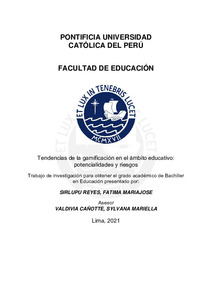| dc.contributor.advisor | Valdivia Cañotte, Sylvana Mariella | |
| dc.contributor.author | Sirlupu Reyes, Fatima Mariajose | |
| dc.date.accessioned | 2022-09-13T22:39:47Z | |
| dc.date.available | 2022-09-13T22:39:47Z | |
| dc.date.created | 2021 | |
| dc.date.issued | 2022-09-13 | |
| dc.identifier.uri | http://hdl.handle.net/20.500.12404/23318 | |
| dc.description.abstract | Este Estado del Arte presenta una revisión sobre las tendencias identificadas en la
implementación de la gamificación en el ámbito educativo, centrándose en las
potencialidades y riesgos de su uso en el aula de clases. En este sentido el propósito
de esta investigación es identificar estas tendencias y comprender las implicaciones,
tanto positivas como negativas, del empleo de sistemas gamificados en los procesos
de enseñanza-aprendizaje. Para ello, se realizó una revisión bibliográfica de actas de
conferencias, artículos de revistas, capítulos de libros, libros, libros blancos, páginas
web y tesis, y se seleccionó aquellos cuyos aportes fuesen relevantes para la
investigación, los cuales abarcan desde el año 2011 hasta el año 2020. Sobre la base
de estos, el trabajo se estructura en dos apartados: “enfoque de la gamificación desde
la motivación extrínseca” y “enfoque de la gamificación desde la motivación
intrínseca”. En estos, se presentan las potencialidades y riesgos del empleo de la
gamificación desde cada uno de estos enfoques. Finalmente, a partir de esta
investigación surgen cuestionamientos sobre la deficiencia de uso del enfoque desde
la motivación intrínseca y el favorecimiento del enfoque intrínseco en el contexto de la
educación formal. También se identifica la necesidad de la estructuración de sistemas
mixtos, que unifiquen características y mecanismos de ambos enfoques. Además, se
reconoce la importancia de la gamificación como una herramienta que es de ayuda
para el docente en los procesos de motivación, y que puede ser favorable para el logro
de aprendizajes significativos y contextualizados, empleada de manera adecuada. | es_ES |
| dc.description.abstract | This study presents a review of the state of the art on the tendencies identified in the
implementation of gamification in education, focusing on the potential and risks of its
use in the classroom. In this sense, the purpose of this research is to identify these
tendencies and understand the implications, both positive and negative, of the
application of gamified systems in the teaching-learning processes. To this end, a
literature review of conference proceedings, journal articles, book chapters, books,
white papers, web pages and theses was conducted, and those whose contributions
were relevant to the research were selected, spanning from 2011 to 2020. Based on
these, the work is structured in two sections: "gamification approach from extrinsic
motivation" and "gamification approach from intrinsic motivation". The potentialities
and risks of using gamification from each of these approaches are presented in these
sections. Finally, this research raises questions about the deficiency of the use of the
intrinsic motivation approach and the favoring of the intrinsic approach in the context
of formal education. It also identifies the need to structure mixed systems that unify the
characteristics and mechanisms of both approaches. In addition, the importance of
gamification is recognized as a tool that helps teachers in motivation processes, and
that can be favorable for the achievement of meaningful and contextualized learning,
if used appropriately. | es_ES |
| dc.language.iso | spa | es_ES |
| dc.publisher | Pontificia Universidad Católica del Perú | es_ES |
| dc.rights | info:eu-repo/semantics/openAccess | es_ES |
| dc.rights.uri | http://creativecommons.org/licenses/by-nc-sa/2.5/pe/ | * |
| dc.subject | Juegos educativos | es_ES |
| dc.subject | Motivación (Psicología) | es_ES |
| dc.subject | Educación--Metodología | es_ES |
| dc.title | Tendencias de la gamificación en el ámbito educativo: potencialidades y riesgos | es_ES |
| dc.type | info:eu-repo/semantics/bachelorThesis | es_ES |
| thesis.degree.name | Bachiller en Educación | es_ES |
| thesis.degree.level | Bachillerato | es_ES |
| thesis.degree.grantor | Pontificia Universidad Católica del Perú. Facultad de Educación | es_ES |
| thesis.degree.discipline | Educación | es_ES |
| renati.advisor.dni | 42352700 | |
| renati.advisor.orcid | https://orcid.org/0000-0001-5480-4299 | es_ES |
| renati.author.dni | 72535897 | |
| renati.discipline | 199996 | es_ES |
| renati.level | https://purl.org/pe-repo/renati/level#bachiller | es_ES |
| renati.type | https://purl.org/pe-repo/renati/type#trabajoDeInvestigacion | es_ES |
| dc.publisher.country | PE | es_ES |
| dc.subject.ocde | https://purl.org/pe-repo/ocde/ford#5.03.01 | es_ES |






